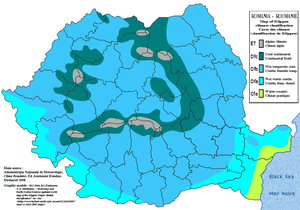| Geography of Romania |
| Topography |
| Hydrography |
| Climate |
The climate of Romania is continental, transitioning into humid subtropical (locally often "warm oceanic" or "Pontic") on the eastern coast, influenced by polar intrusions, and therefore characterized by harsh winters. The mountain ranges of the Carpathian arc have a cool mountain climate with high humidity throughout the year.[1]
Rainfall, although adequate throughout the country, decreases from west to east and from mountains to plains. Some mountainous areas receive more than 1,010 mm (39.8 in) of precipitation each year. Annual precipitation averages about 635 mm (25 in) in central Transylvania, 521 mm (20.5 in) at Iaşi in Moldavia, and only 381 mm (15 in) at Constanţa on the Black Sea.

Summers in the country are generally very warm to hot, and temperatures over 35 °C (95 °F) are not unknown in the lower-lying areas of the country. Night time lows in Bucharest and other lower-lying areas are around 16 °C (60.8 °F), but at higher altitudes both maxima and minima decline considerably.

In the coldest months of winter (December and January) temperatures average between 3˚C and -15˚C. During winter, the skies are often cloudy and snowfall is quite common. In the plains of Romania there are about thirty days with snowfall per year.
- ^ "Meteo Romania – Clima Romaniei". www.meteoromania.ro.